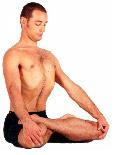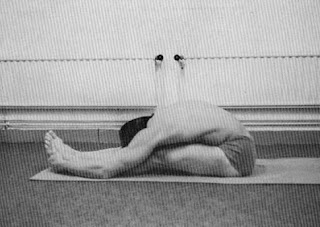Ashtanga Yoga: Capturing Prana II

Contemplating your navel
The solar plexus is located just back of the pit of the stomach on either side of the spinal column. The name “solar” is well bestowed upon this major nerve plexus, as it radiates energy to all parts of the body. According to the yogic texts it is the great storehouse of prana, the manipura chakra. Other Eastern cultures link it to the hara, dan tien, center of chi or ki. It’s the center of our being from the umbilical cord to adulthood. It‘s the place where you get that gut feeling, the intuitive sense. We’ve got to keep it healthy, tuned in and alive.
Uddiyana Bandha • The Flying Bandha
Practice
Uddiyana bandha
1. Stand with feet about two feet apart. Bend the knees slightly and rest the hands above the knees, with the thumbs facing inwards and the fingers outwards. The spine must emain straight, not curved; the head should be kept up and eyes open. Inhale deeply through the nose, then exhale quickly through slightly pursed lips, but don’t be forceful. Having fully exhaled, bring the chin to the chest ( jalandhara bandha), raising the shoulders. Pull the abdomen and stomach inward toward the spine and up. Hold for a few seconds. Before inhaling, relax the stomach and abdomen, raise the head and stand straight. Then inhale through the nose slowly and with control. Before repeating another round, breathe normally for a minute or two. Start with three rounds and over a period of a few months increase to ten rounds.
2. Sit in a comfortable cross-legged position ( padmasana, siddhasana or sukhasana, depending on your flexibility). Sit on a cushion so that the buttocks are raised. Keep the palms of the hands on the knees and the spinal cord upright and straight. Eyes may be open or closed. Begin as above, practicing three to ten rounds, concentrating on the natural breath for a minute or two between rounds.
3. Stand up and experiment moving from the middle of your body, try walking as if there is a string attached to your navel pulling you forward.
4. Practice the bandhas at different times during the day. Notice the effect on your energy level.
5.Notice any fears that arise when you’re practicing the bandhas.
6. Connect the breath, mula bandha, and uddiyana bandha, and try to relax while maintaining the locks.
Padmasana
Movement of shakti in the body is described as a bird. Shakti is the personification of the feminine form of the Divine. Through the practice of the flying bandha, the great bird (Shakti) flies upward with ease, further directing the flow of prana toward higher states of consciousness. By contracting the lower abdomen and pulling it inward and upward, toward the spine, a powerful toning effect and internal strengthening occurs. This lifting helps push up the diaphragm and expel the breath. Uddiyana bandha, the abdominal lock, also eliminates strain by helping to control the breath. Control of the breath controls consciousness. Bandhas are a means of extending control over the breath and thus are a means to extend our access to consciousness.



Comments